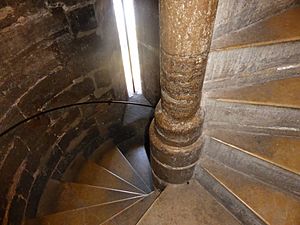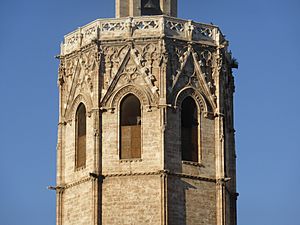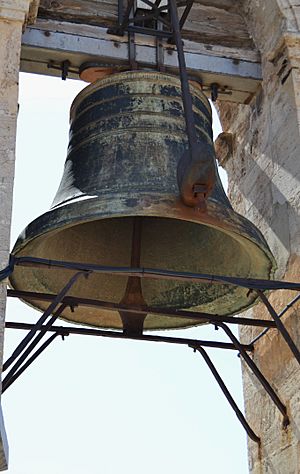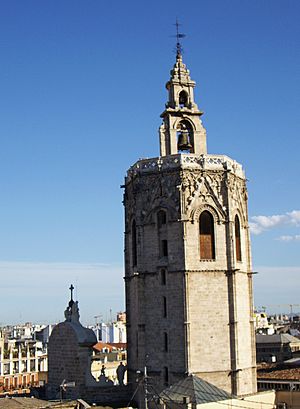Miguelete Tower facts for kids
Quick facts for kids Miguelete Tower |
|
|---|---|
|
El Miguelete
|
|
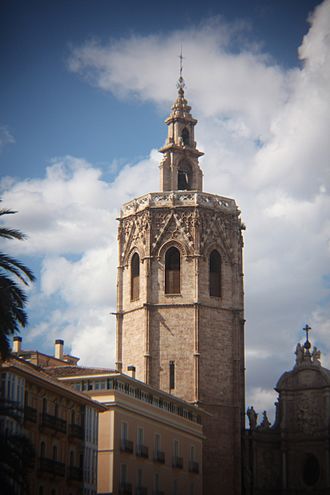
The Miguelete Tower attached to the Valencia Cathedral
|
|
| Alternative names | Torre del Micalet Valencian language |
| General information | |
| Type | Bell tower |
| Architectural style | Valencian Gothic |
| Address | Plaça de la Reina, València, 46001, Valencia, Spain |
| Town or city | Valencia |
| Country | Valencian Community, Spain |
| Coordinates | 39°28′31″N 0°22′32″W / 39.4753°N 0.3756°W |
| Construction started | 1381 |
| Completed | 1429 |
| Height | 63 m. (206.7 ft.) |
| Design and construction | |
| Architect | Andreu Julià, Pere Balaguer |
The Miguelete Tower is a famous bell tower in Valencia, Spain. It belongs to the Valencia Cathedral. People call it El Miguelete in Spanish or Torre del Micalet in the Valencian language. Building the tower started in 1381 and finished in 1429. Many master builders worked on it because it was a big and complex project. The first builder was Andreu Juliá, starting in 1381. Other important builders included José Franch, Pedro Balaguer, and Martí Llobet. The very top part, called the belfry, was added much later, between 1660 and 1736.
Contents
History of the Miguelete Tower
The Miguelete Tower is built in the Valencian Gothic style. It stands 51 meters (about 167 feet) tall to its main terrace. The total height, including the belfry, is 63 meters (about 207 feet). The tower has eight sides, like an octagon. To reach the top, you need to climb 207 steps!
For a long time, people called it "New Bell" or "Champ of the Cathedral." This was to tell it apart from an "Old Bell" tower that was already there. Over time, its name changed to "Torre del Miguelete." This name came from its largest bell, which is also called El Miguelete.
The Miguelete Tower was first built as a separate structure. It was connected to the Cathedral in the late 1400s when the main part of the church was made longer. You can enter the tower through a special doorway with fancy arches. The tower's eight sides have strong diagonal supports on the corners. Fine lines on the outside show the different levels inside.
The first level of the tower is solid, except for the spiral staircase. The second level used to be a prison or a safe place for people seeking asylum. It has one window. The third level was the "Home of the Bell-Ringer." This room is similar to the one below but larger, with two windows. The very top floor is the bell room. It has eight windows, and seven of them hold bells. The eighth window is where the spiral staircase continues, becoming narrower.
By 1425, the main part of the tower was finished up to the terrace. However, the plan for a tall, pointed spire was never completed.
The famous El Miguelete bell, which tells the hours, used to hang from a wooden frame. This was a common way to hang bells in towers across the Crown of Aragon. The belfry you see today was added later, between 1660 and 1736. The terrace once had a beautiful openwork crown. This crown was removed in the 1700s. It was replaced first by a wooden railing, then a metal one in the 1800s. The original look was restored in 1983.
The third level of the tower was often home to the people who rang the bells. The last bell-ringer to live in the Miguelete Tower was Mariano Folch. He took care of the bells for over sixty years and passed away around 1905.
In 1940, a bell named Eloy was added to the original eleven bells. This bell came from the Santa Catalina Church tower. Adding Eloy changed the overall sound of the bells.
Changes in the 1980s
The bell room stayed mostly the same until the bells were made electric. This meant removing the old wooden doors and changing parts like the yokes and ratchets. A large beam that held two smaller bells was also removed. Traditionally, only the five largest bells of the Cathedral were rung for important events. Other bells were used for funerals or special occasions.
The electrification, done by The Roses Brothers, changed how the bells were rung. Six bells were mechanized: two small ones, one medium one (Barbara), and three of the smaller large ones (Vicente, Andrés, and Jaime). This changed the grand ringing of the five main bells to a more common style. The mechanization was a big change. It meant that the machines could not copy the many different traditional ringing styles. Also, the new setup made it impossible to ring the bells by hand.
Because of money limits, only six of the twelve bells were mechanized at that time. The other six bells kept their original setup. However, the problems with the machines became clear in 1988. The Valencia Bell Tower Guild was asked to ring the bells for a procession. Several bells needed major repairs to ring, and one could not be rung at all.
The Tower Today
The bells, their equipment, and the tower itself are always being restored and maintained. This work is done by the Valencian Bell Tower Guild and now by the Bell Ringers of the Cathedral of Valencia. They get money from the Valencian Government and the City Council of Valencia.
The six iron yokes on the mechanized bells were replaced with wooden ones. The wooden windows in the bell room, which help the sound travel, were also replaced. The platform where the bell ringers stand was made safer and higher. This helps them see their work better. The rooms now have new electric wires and barred doors. These doors let visitors see inside, even when the rooms are closed.
The electronic systems that ring the bells automatically every day have been updated twice. This is because technology changes quickly. On December 25, 2014, the Jaume bell was damaged. To fix it, parts of the bell were cut and drilled.
The Bells of the Cathedral
The Valencia Cathedral has three groups of bells, used for different purposes and located in different places. The bells in the main Bell Tower are still actively used.
On the dome's roof, there is an old signal bell that is no longer used.
In the belfry of the Bell Tower are the two clock bells. One is from 1736 and rings the quarter hours. The other is El Miguelete, which only rings the hours. This large bell gives the tower its name. It is the biggest bell ever used in the Crown of Aragon. It was first cast in 1418 and had to be recast several times, most recently in 1539.
In the Bell Room, there are eleven bells from when the building was first made. In medieval times, people called them "the five big ones and the six small ones." These bells are used for daily ringing, festivals, funerals, and special events. The oldest bell is Catherine, from 1305. It is the oldest bell still used in the entire Crown of Aragon. The newest bell is Violante, from 1735. Other smaller bells include Ursula (1438), Barbara (1681), Paul (1489), and Narcissus (1529). The larger bells are Vincent (1569), Andrew (1604), Manuel (1621), Jaime (1429), and María (1544).
The Miguelete Tower has one of the largest collections of Gothic bells in Spain. This includes two large Gothic bells (Catalina and Jaime) and six smaller Gothic ones (Ursula, Pablo, Narciso, Vicente, Andrés, and María), plus El Miguelete itself.
Only the bells in the windows and El Miguelete for the clock are automated. Barbara is used for daily choir ringing, Manuel for ringing to close the city gates, and María for prayer calls. These three bells can still be rung by hand.
Traditional Bell Ringing
Since it was built, the Miguelete Tower has had a written list of how its bells should be rung. This was part of the Cathedral's customs. From the mid-1400s, the bells were swung and rung. By the 1500s, ringing all the bells in a full circle became popular, starting with María, the largest bell. There were different ways to ring the bells throughout the day, week, and year. The ringing also changed depending on the season. There were special rings for funerals and for festivals. The festival rings only used the five largest bells. There were also rings for storms, to help souls, or as an alarm. The City Council of Valencia was in charge of the ringing that announced the closing of the city gates.
Over the centuries, the bell ringing changed to fit the needs of both the Cathedral and the city.
When the bells became electric, it broke many traditions. Only some bells were turned, and the special "chorus" rings disappeared. Funeral rings were also greatly reduced. The unique "peals," which were the most creative and ancient way of ringing the bells, stopped. These peals used to sound more than two hundred times a year. They also stopped the daily prayer signals and the city gate closing signals. Now, the new bell rings mostly just announce masses. The original meaning of the bells, which was to accompany community events with loud music, is mostly lost.
Current Bell Ringing
In the first years of the Valencian Bell Towers Guild's work, some bell rings were still automatic. Four of the electrified bells still had their motors. However, after a big restoration in 1992, only Barbara's motor was left. This bell warns the daily choir. There were also outside systems to ring Manuel (for closing city gates) and María (for prayers) by pulling a rope.
Today, there are two main types of bell rings: automatic and manual. The automatic rings are for prayer signals. These include three sounds from María's clapper for the Angelus prayer and five sounds for the Souls' peal. Manuel rings for half an hour to signal the closing of city gates, starting slowly and then speeding up. Barbara rings three times for the choir at specific times in the morning. There are also two automatic Angelus peals on Saturday and Sunday afternoons, and a last worship peal on Saturday evenings.
The manual bell rings are performed by the Bell Ringers of the Cathedral of Valencia. They are part of the Valencian Federation of Bell Groups. Their yearly calendar includes all the church holidays, Advent and Lent Sundays, and special celebrations. This is all written down in a new guide called the Consueta Nova. It is based on an old guide from 1705 but updated for today's needs. For example, the old tradition of announcing a feast day from noon the day before has mostly stopped. This is because the current bell ringers are volunteers who have jobs or school and live far from the city center. Now, it makes more sense to ring the bells at noon on holidays. This helps build a sense of community when people are walking through the historic center. Three dawn peals are still done: for the Virgin of the Forsaken, for Corpus Christi, and for the Assumption of Mary.
Generally, the bells are turned using ropes. This brings back traditional ways of stopping and flipping the bells that the last bell ringers before electrification had perfected. It also allows for changing rhythms. Special bearings make it easier to ring the bells. Most of the bell frames will be kept as long as they work safely and without too much effort. However, María, Catalina, Narcissus, and Pablo still have their original setups.
Visiting the Tower
You can visit the Miguelete Tower every day of the year. You just need to buy a ticket from the cathedral. After the Bell Ringers of the Cathedral of Valencia perform, visitors can see the three rooms of the bell tower through barred doors. Then, you can continue climbing to the terrace at the very top.
The Cathedral Chapter manages the tower, except for visits to the bell room.
See also
 In Spanish: El Miguelete para niños
In Spanish: El Miguelete para niños


